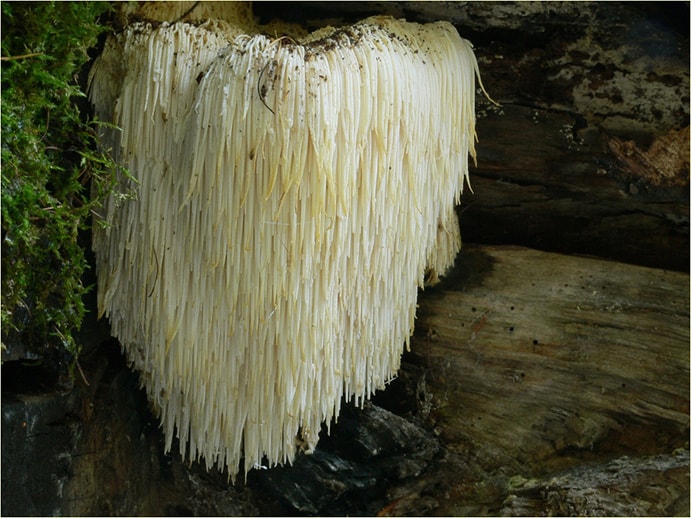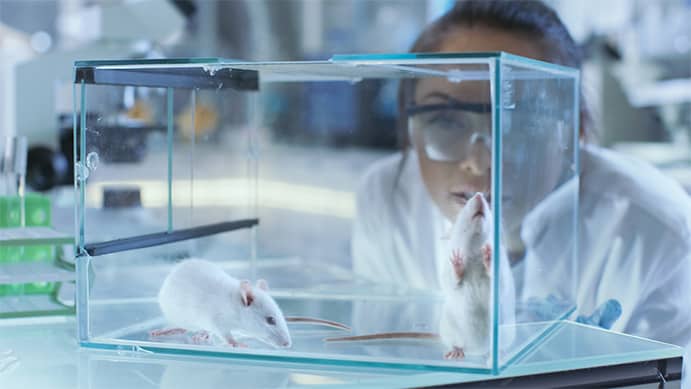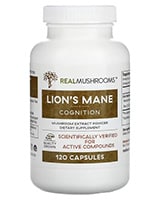
Lion’s Mane mushroom is an edible fungus from the tooth fungus group also known as “Yamabushitake” or Hericium erinaceus. Native to North America, Europe, and Asia, Lion’s Mane is not only a well-regarded foodstuff but also used in traditional medicine for its medicinal properties.

Lion’s Mane is uncommon in the wild, but because it takes well to cultivate, it is commonly used as a food source in Japan and China. For a meal, it can be sliced into steaks and simmered with butter and spices.[1]de la Vega, J. (2015). An Important Introduction to Cooking Lion’s Mane Mushroom. Randwiches. Available at: http://www.randwich.es/blog/2015/10/19/pan-fried-lions-mane-mushroom [Accessed April 5, 2018]. For herbal remedies, it can be made into a tincture or ground into a powder[2]Pugle, M. (2023). Benefits of Taking Lion’s Mane Mushroom. Verywell Health. Retrieved from https://www.verywellhealth.com/lions-mane-7500313.
Recently, Lion’s Mane has come under scientific scrutiny for its neuro-regenerative effects. Bench research, animal studies in nerve crush injuries, and human studies in early cognitive decline and depression all suggest that it may have the potential to restore, or at least ameliorate cognitive and neurological deficits.
>> Looking to Buy Lion’s Mane Mushroom? Click here to see our recommended sellers.
The Science on Neuro regenerative Properties of Lion’s Mane
In Asian traditional medicine, the purported benefits of Lion’s Mane include a panoply of cures including:
antibiotic, anticarcinogenic, antidiabetic, anti-fatigue, antihypertensive, antihyperlipidemic, anti-senescence, cardioprotective, hepatoprotective, nephroprotective, and neuroprotective properties and improvement of anxiety, cognitive function, and depression[3]Friedman, M. (2015). Chemistry, Nutrition, and Health-Promoting Properties of Hericium erinaceus (Lion’s Mane) Mushroom Fruiting Bodies and Mycelia and Their Bioactive Compounds. J. Agric. Food Chem. 63, 7108–7123.
Lion’s Mane has been in use as a traditional Chinese medicine therapy for gastritis for 1000 years,[4]Ma, B. J., Shen, J. W., Yu, H. Y., Ruan, Y., Wu, T. T., and Zhao, X. (2010). Hericenones and erinacines: stimulators of nerve growth factor (NGF) biosynthesis in Hericium erinaceus. Mycology 1, 92–98. scientific examination of its therapeutic uses is more recent. Some of the most exciting science on the fungus involves its neuro-regenerative effects.
Neuro regenerative compounds
The current scientific buzz on Lion’s Mane is exciting because it may be beneficial in high-profile cognitive and neurological diseases that currently have no cure[5]Friedman, M. (2015). Chemistry, Nutrition, and Health-Promoting Properties of Hericium erinaceus (Lion’s Mane) Mushroom Fruiting Bodies and Mycelia and Their Bioactive Compounds. J. Agric. Food Chem. 63, 7108–7123..
In the 1990s, scientists found compounds associated with stimulation of nerve growth factor (NGF) synthesis (hericenones C–H[6]Kawagishi, H., Ando, M., Shinba, K., Sakamoto, H., Yoshida, S., Ojima, F., Ishiguro, Y., Ukai, N., and Furukawa, S. (1992). Chromans, hericenones F, G and H from the mushroom Hericium erinaceum. Phytochemistry 32, 175–178.[7]Kawagishi, H., Ando, M., and Mizuno, T. (1990). Hericenone A and B as cytotoxic principles from the mushroom Hericium erinaceum. Tetrahedron letters 31, 373–376.[8]Kawagishi, H., Ando, M., Sakamoto, H., Yoshida, S., Ojima, F., Ishiguro, Y., Ukai, N., and Furukawa, S. (1991). Hericenones C, D and E, stimulators of nerve growth factor (NGF)-synthesis, from the mushroom Hericium erinaceum. Tetrahedron Letters 32, 4561–4564. and erinacines A–I)[9]Kawagishi, H., Shimada, A., Shirai, R., Okamoto, K., Ojima, F., Sakamoto, H., Ishiguro, Y., and Furukawa, S. (1994). Erinacines A, B and C, strong stimulators of nerve growth factor (NGF)-synthesis, from the mycelia of Hericium erinaceum. Tetrahedron letters 35, 1569–1572.[10]Kawagishi, H., Shimada, A., Hosokawa, S., Mori, H., Sakamoto, H., Ishiguro, Y., Sakemi, S., Bordner, J., Kojima, N., and Furukawa, S. (1996). Erinacines E, F, and G, stimulators of nerve growth factor (NGF)-synthesis, from the mycelia of Hericium erinaceum. Tetrahedron Letters 37, 7399–7402.[11]Lee, E. W., Shizuki, K., Hosokawa, S., Suzuki, M., Suganuma, H., Inakuma, T., Li, J., Ohnishi-Kameyama, M., Nagata, T., Furukawa, S., et al. (2000). Two novel diterpenoids, erinacines H and I from the mycelia of Hericium erinaceum. Biosci. Biotechnol. Biochem. 64, 2402–2405. in the fruit body and mycelium of Lion’s Mane.
This discovery is notable because common neurodegenerative diseases like Alzheimer’s disease are associated with reduced cholinergic neurons in the brain[12]Ferreira-Vieira, T. H., Guimaraes, I. M., Silva, F. R., and Ribeiro, F. M. (2016). Alzheimer’s disease: Targeting the Cholinergic System. Curr. Neuropharmacol. 14, 101–115.. Because NGF promotes the differentiation and survival of cholinergic neurons in the brain and spinal cord, it could theoretically be used to treat dementia[13]Ferreira-Vieira, T. H., Guimaraes, I. M., Silva, F. R., and Ribeiro, F. M. (2016). Alzheimer’s disease: Targeting the Cholinergic System. Curr. Neuropharmacol. 14, 101–115.. However, the NGF protein itself is unable to cross from blood to the brain, so research is being carried out on low-molecular-weight compounds such as hericenones and erinacines that promote NGF biosynthesis[14]Ma, B. J., Shen, J. W., Yu, H. Y., Ruan, Y., Wu, T. T., and Zhao, X. (2010). Hericenones and erinacines: stimulators of nerve growth factor (NGF) biosynthesis in Hericium erinaceus. Mycology 1, 92–98..
Because of its association with hericenones and erinacines, Lion’s Mane has been further evaluated in cell, animal and human studies for neuroregenerative effects.
Neuronal cell lines
In 2007, aqueous extracts of Lion’s Mane were shown to stimulate neurite outgrowth in the NG108-15 cell line (an in vitro neuronal model composed of rat/mouse glioma cells).[15]Wong, K. H., Sabaratnam, V., Naidu, M., and Keynes, R. (2007). Activity of aqueous extracts of lion’s mane mushroom Hericium erinaceus (Bull.: Fr.) Pers.(Aphyllophoromycetideae) on the neural cell line NG108-15. International Journal of Medicinal Mushrooms 9.
However, a 2013 study that compared the neurite outgrowth from Lion’s Mane against that stimulated by other edible fungi, showed that it might not be the highest impact mushroom in this class, Lignosus rhinocerotis and Ganoderma lucidum had even greater effects[16]Phan, C.-W., David, P., Naidu, M., Wong, K.-H., and Sabaratnam, V. (2013). Neurite outgrowth stimulatory effects of culinary-medicinal mushrooms and their toxicity assessment using differentiating Neuro-2a and embryonic fibroblast BALB/3T3. BMC Complement. Altern. Med. 13, 261..
A subsequent study was done in 2015 to compare Lion’s Mane against Lignosus rhinocerotis. In this study, both fungi performed roughly equivalent, stimulating neurite outgrowth in in vitro cells from the brain, spinal cord, and retina of chick embryos. However, Lion’s Mane exerted its maximum effects at a concentration of 50 µg/mL, while L. rhinocerotis had maximum effects at different concentrations depending on the tissue.[17]Samberkar, S., Gandhi, S., Naidu, M., Wong, K.-H., Raman, J., and Sabaratnam, V. (2015). Lion’s Mane, Hericium erinaceus and Tiger Milk, Lignosus rhinocerotis (Higher Basidiomycetes) Medicinal Mushrooms Stimulate Neurite Outgrowth in Dissociated Cells of Brain, Spinal Cord, and Retina: An In Vitro Study. Int. J. Med. Mushrooms 17, 1047–1054.
For those interested in specific mechanisms, a 2014 study examined neurite outgrowth in rat pheochromocytoma (PC12) cell lines. The authors measured NGF protein levels and evaluated secondary metabolites to conclude that Lion’s Man acted via hericenone E to stimulate the MEK/ERK and PI3K/Akt pathways.[18]Phan, C.-W., Lee, G.-S., Hong, S.-L., Wong, Y.-T., Brkljača, R., Urban, S., Abd Malek, S. N., and Sabaratnam, V. (2014). Hericium erinaceus (Bull.: Fr) Pers. cultivated under tropical conditions: isolation of hericenones and demonstration of NGF-mediated neurite outgrowth in PC12 cells via MEK/ERK and PI3K-Akt signaling pathways. Food Funct. 5, 3160–3169.
Animal models
A 2014 study examining peripheral nerve regeneration in rats found that an aqueous extract of Lion’s Mane promoted early functional recovery. For adult female Sprague-Dawley rats with axonotmetic peroneal nerve injury, functional recovery was assessed by the Peroneal Functional Index (PFI) from walking-track analysis and toe-spreading reflex. Rats that were treated daily with the aqueous extract recovered several days earlier than untreated controls on both measures.

One of the most exciting papers on Lion’s Mane was a 2011 paper looking at amyloid plaque formation in a mouse model for Alzheimer’s Disease. Mice were fed Lion’s Mane for 23 days, then the amyloid β(25-35) peptide which induces symptoms of dementia. Mice treated with Lion’s Mane did not develop impairment of spatial short-term and visual recognition memory as compared to controls which indicated it may prevent dementia[19]Mori, K., Obara, Y., Moriya, T., Inatomi, S., and Nakahata, N. (2011). Effects of Hericium erinaceus on amyloid β(25-35) peptide-induced learning and memory deficits in mice. Biomed. Res. 32, 67–72..
Human Studies
In a 2009 human study, Japanese scientists did a randomized placebo-controlled clinical trial of Lion’s Mane in patients aged 50-80 who were diagnosed with mild cognitive impairment. The results were exciting, patients who took four 250 mg tablets containing 96% Lion’s Mane dry powder three times a day for 16 weeks scored significantly above patients with placebo on cognitive scales after taking the supplement for 8 weeks (as measured by the Revised Hasegawa Dementia Scale or HDS-R). There were no adverse effects from the treatment although the effect did stop when the supplement was discontinued[20]Mori, K., Inatomi, S., Ouchi, K., Azumi, Y., and Tuchida, T. (2009). Improving effects of the mushroom Yamabushitake (Hericium erinaceus) on mild cognitive impairment: a double-blind placebo-controlled clinical trial. Phytother. Res. 23, 367–372..

In a 2010 human study, Lion’s Mane was evaluated for its effects on menopause, depression, sleep quality and “indefinite complaints”. Thirty females took Lion’s Mane or a placebo for 4 weeks. Scientists found that the group taking Lion’s Mane scored significantly lower on depression (as measured by the Epidemiologic Studies Depression Scale (CES-D)) than controls taking a placebo. They concluded that H. erinaceus has potential as an antidepressant therapy[21]Nagano, M., Shimizu, K., Kondo, R., Hayashi, C., Sato, D., Kitagawa, K., and Ohnuki, K. (2010). Reduction of depression and anxiety by 4 weeks Hericium erinaceus intake. Biomed. Res. 31, 231–237..
Conclusions about Neuro regenerative Effects of Lion’s Mane
While the science on Lion’s Mane is still young, the fungi hold potential for targeted neurological therapies.
As Lion’s Mane has been consumed as a foodstuff for centuries, and some human studies show cognitive benefit with no ill effects it seems like a reasonable dietary addition for those interested in food-as-medicine therapies.
Hopefully, Lion’s Mane will receive more scientific attention in future. Stay tuned for evolving research on the topic.
Buy Lion’s Mane Mushroom Online Review Comparison Table
| Product | Company | Quantity | Price | Country | Website |
 Lion's Mane Mushroom | iHerb | 120 pills (1000mg) | $29.95 |  Worldwide, AU | Visit Website >> |
Originally posted on April 15, 2018, last updated on October 13, 2023.
References
| ↑1 | de la Vega, J. (2015). An Important Introduction to Cooking Lion’s Mane Mushroom. Randwiches. Available at: http://www.randwich.es/blog/2015/10/19/pan-fried-lions-mane-mushroom [Accessed April 5, 2018]. |
|---|---|
| ↑2 | Pugle, M. (2023). Benefits of Taking Lion’s Mane Mushroom. Verywell Health. Retrieved from https://www.verywellhealth.com/lions-mane-7500313 |
| ↑3, ↑5 | Friedman, M. (2015). Chemistry, Nutrition, and Health-Promoting Properties of Hericium erinaceus (Lion’s Mane) Mushroom Fruiting Bodies and Mycelia and Their Bioactive Compounds. J. Agric. Food Chem. 63, 7108–7123. |
| ↑4, ↑14 | Ma, B. J., Shen, J. W., Yu, H. Y., Ruan, Y., Wu, T. T., and Zhao, X. (2010). Hericenones and erinacines: stimulators of nerve growth factor (NGF) biosynthesis in Hericium erinaceus. Mycology 1, 92–98. |
| ↑6 | Kawagishi, H., Ando, M., Shinba, K., Sakamoto, H., Yoshida, S., Ojima, F., Ishiguro, Y., Ukai, N., and Furukawa, S. (1992). Chromans, hericenones F, G and H from the mushroom Hericium erinaceum. Phytochemistry 32, 175–178. |
| ↑7 | Kawagishi, H., Ando, M., and Mizuno, T. (1990). Hericenone A and B as cytotoxic principles from the mushroom Hericium erinaceum. Tetrahedron letters 31, 373–376. |
| ↑8 | Kawagishi, H., Ando, M., Sakamoto, H., Yoshida, S., Ojima, F., Ishiguro, Y., Ukai, N., and Furukawa, S. (1991). Hericenones C, D and E, stimulators of nerve growth factor (NGF)-synthesis, from the mushroom Hericium erinaceum. Tetrahedron Letters 32, 4561–4564. |
| ↑9 | Kawagishi, H., Shimada, A., Shirai, R., Okamoto, K., Ojima, F., Sakamoto, H., Ishiguro, Y., and Furukawa, S. (1994). Erinacines A, B and C, strong stimulators of nerve growth factor (NGF)-synthesis, from the mycelia of Hericium erinaceum. Tetrahedron letters 35, 1569–1572. |
| ↑10 | Kawagishi, H., Shimada, A., Hosokawa, S., Mori, H., Sakamoto, H., Ishiguro, Y., Sakemi, S., Bordner, J., Kojima, N., and Furukawa, S. (1996). Erinacines E, F, and G, stimulators of nerve growth factor (NGF)-synthesis, from the mycelia of Hericium erinaceum. Tetrahedron Letters 37, 7399–7402. |
| ↑11 | Lee, E. W., Shizuki, K., Hosokawa, S., Suzuki, M., Suganuma, H., Inakuma, T., Li, J., Ohnishi-Kameyama, M., Nagata, T., Furukawa, S., et al. (2000). Two novel diterpenoids, erinacines H and I from the mycelia of Hericium erinaceum. Biosci. Biotechnol. Biochem. 64, 2402–2405. |
| ↑12, ↑13 | Ferreira-Vieira, T. H., Guimaraes, I. M., Silva, F. R., and Ribeiro, F. M. (2016). Alzheimer’s disease: Targeting the Cholinergic System. Curr. Neuropharmacol. 14, 101–115. |
| ↑15 | Wong, K. H., Sabaratnam, V., Naidu, M., and Keynes, R. (2007). Activity of aqueous extracts of lion’s mane mushroom Hericium erinaceus (Bull.: Fr.) Pers.(Aphyllophoromycetideae) on the neural cell line NG108-15. International Journal of Medicinal Mushrooms 9. |
| ↑16 | Phan, C.-W., David, P., Naidu, M., Wong, K.-H., and Sabaratnam, V. (2013). Neurite outgrowth stimulatory effects of culinary-medicinal mushrooms and their toxicity assessment using differentiating Neuro-2a and embryonic fibroblast BALB/3T3. BMC Complement. Altern. Med. 13, 261. |
| ↑17 | Samberkar, S., Gandhi, S., Naidu, M., Wong, K.-H., Raman, J., and Sabaratnam, V. (2015). Lion’s Mane, Hericium erinaceus and Tiger Milk, Lignosus rhinocerotis (Higher Basidiomycetes) Medicinal Mushrooms Stimulate Neurite Outgrowth in Dissociated Cells of Brain, Spinal Cord, and Retina: An In Vitro Study. Int. J. Med. Mushrooms 17, 1047–1054. |
| ↑18 | Phan, C.-W., Lee, G.-S., Hong, S.-L., Wong, Y.-T., Brkljača, R., Urban, S., Abd Malek, S. N., and Sabaratnam, V. (2014). Hericium erinaceus (Bull.: Fr) Pers. cultivated under tropical conditions: isolation of hericenones and demonstration of NGF-mediated neurite outgrowth in PC12 cells via MEK/ERK and PI3K-Akt signaling pathways. Food Funct. 5, 3160–3169. |
| ↑19 | Mori, K., Obara, Y., Moriya, T., Inatomi, S., and Nakahata, N. (2011). Effects of Hericium erinaceus on amyloid β(25-35) peptide-induced learning and memory deficits in mice. Biomed. Res. 32, 67–72. |
| ↑20 | Mori, K., Inatomi, S., Ouchi, K., Azumi, Y., and Tuchida, T. (2009). Improving effects of the mushroom Yamabushitake (Hericium erinaceus) on mild cognitive impairment: a double-blind placebo-controlled clinical trial. Phytother. Res. 23, 367–372. |
| ↑21 | Nagano, M., Shimizu, K., Kondo, R., Hayashi, C., Sato, D., Kitagawa, K., and Ohnuki, K. (2010). Reduction of depression and anxiety by 4 weeks Hericium erinaceus intake. Biomed. Res. 31, 231–237. |

Leave a Reply